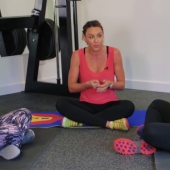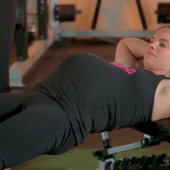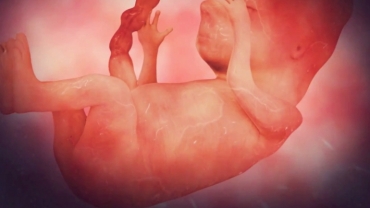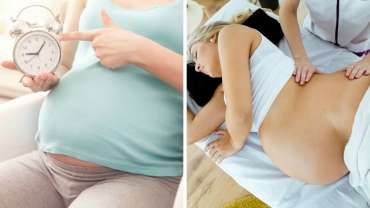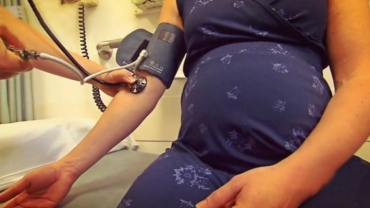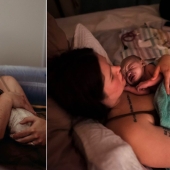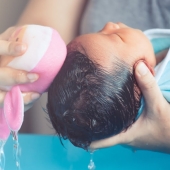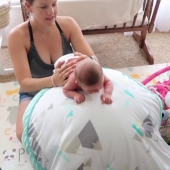Wouldn’t it be nice if babies came with instructions? Lots of parents have questions about how to change diapers or give baby a bath. We’ll talk you through it. At home, give your baby sponge baths until the umbilical cord stump heals – usually 2 to 4 weeks.
Here’s what you do: Get everything you need for the bath ready and close by. You always want to keep one hand on the baby for safety, and of course never leave baby alone even for a second.
Undress your baby in a warm room, and keep wrapped in a towel. You can unwrap different body parts as you wash them, so that your baby doesn’t have to be naked all at once. Starting with your baby’s face, wipe the nose, ears, and eyes with warm water and a washcloth.
Make sure to clean the creases under the arms and neck, and the genital area. Keep the umbilical stump area dry. Once the stump falls off, you can give your baby a bath in the sink or a baby bathtub. Fill a clean sink with 2 to 3 inches of warm water.
Check the temperature to make sure it’s not too hot. Remember to always support your baby’s head. You can use a gentle, unscented baby shampoo to wash the hair. Rinse with a washcloth and pat dry with a soft towel. There’s no need to use lotion. If you choose to do so, make sure it’s gentle and unscented. The umbilical cord will heal on its own. Keep it clean and dry. And don’t use alcohol or cover it.
Erika: Um, the first bath is at, um, Victor’s grandma. Uh, we have a ritual where she gives the bath of, uh, all the newborn children. I was very lucky that she has helped us assist with our first new bath.
Victor: It’s like a Latino thing that she decided to do it, and, uh, Erika was okay with it and my grandma was like, “Let me do this.” So, it worked out. And I think like it helped, because she like saw it for the first time how to do it, and my grandma had done it like several, several, several times with many babies, so it was good.
Bath time is a good chance to examine your baby’s skin from head to toe. Several skin conditions are quite common in newborns and aren’t cause for concern. You may notice any of these things, which usually go away over time:
- White bumps.
- Blotchy, red skin.
- Dry, flaky skin.
- Reddish marks around the forehead, eyes, or the back of the neck.
- Dark blue mark on the buttocks or lower back.
- “Baby Acne.”
- Cradle cap, or a flaky scalp.
What about nails? Baby’s nails grow fast! You can use a baby nail file or infant clippers to cut the nails as they grow. One word of advice is to do this when your baby is sleeping. Babies can be very wiggly, even at this stage!
Many parents also wonder, “How many diapers will my baby go through in a day?” Probably around 10. Making lots of wet diapers helps you know your baby is getting enough to eat.
Let’s talk about poop. The baby’s first stool is dark, green, sticky and called meconium. You should see your baby’s poop change over the first few days. Some babies, especially those who are breastfed, have several bowel movements each day. Other babies poop once a day, or every other day.
For girls, always wipe front to back to prevent urinary tract infections. And if your baby has swollen breasts or labia, or a milky and sometimes slightly bloody discharge from her vagina, these are also normal and will go away on their own.
For boys, be ready with a fresh diaper to cover his penis in case he urinates as you’re changing him. If your baby is uncircumcised, there’s nothing special you need to do to keep the area clean. Just be careful to treat the foreskin gently and don’t pull it back.
If your baby boy is circumcised, you can gently wipe the tip of the penis with warm water, and apply petroleum jelly as directed by your doctor. If your baby has a plastic ring around the head of the penis, it will fall off within 4 to 10 days. A brownish-black crust is normal as the penis heals.
Please call your doctor immediately if you notice any of these signs:
- Spots of blood in the diaper larger than a quarter.
- Redness, pain, or swelling that gets worse instead of better.
- Pus-filled blisters.
- Fever of 100.4 degrees Fahrenheit or greater.
- Yellow crusts that last longer than 7 days.
- 6053 views


